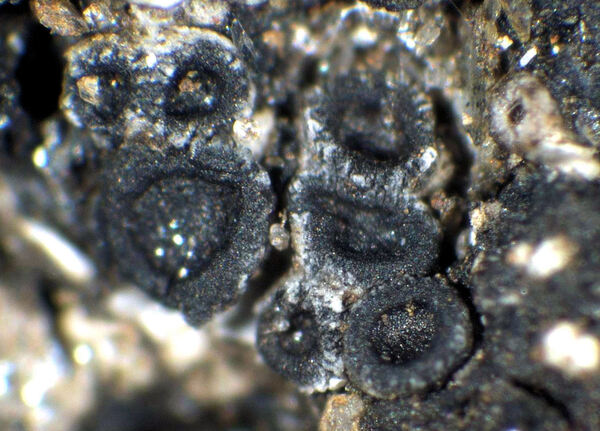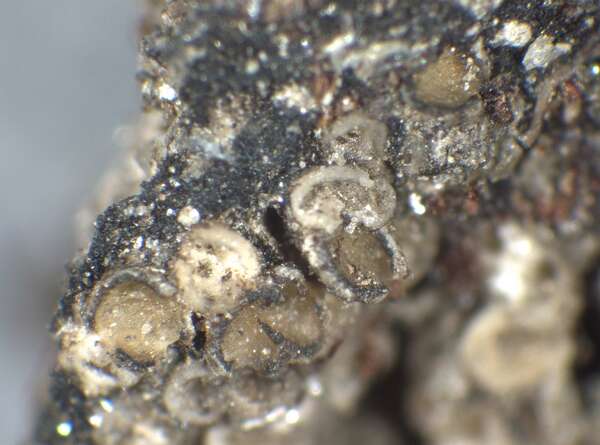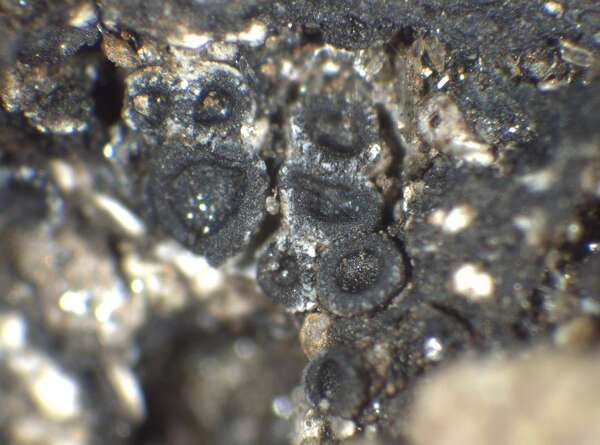Gyalidea scutellaris (Bagl. & Carestia) Lettau
Feddes Rep. Beih., 69: 123, 1937. Basionym: Gyalecta scutellaris Bagl. & Carestia - Comm. Soc. Critt. Ital., 1, 5: 442, 1864.
Synonyms: Gyalecta arctica Malme; Gyalecta pseudogeoica Anzi
Description: Thallus crustose, episubstratic, whitish to grey- or green-brown, darker when dry, thin, continuous. Apothecia lecideine, sessile, 0.5-0.8 mm across, translucent when wet, with a pale brown to brown-black (paler when wet), strongly concave disc, and a thick, rough, entire or radially sulcate, usually paler proper margin which is sometimes laterally covered with a whitish, finally excluded thalline layer. Proper exciple 40-60 µm wide laterally, pale yellowish brown to dark brown in outer part, colourless within; epithecium colourless to very pale yellowish brown; hymenium colourless, 130-140 µm high, the hymenial gel I+ yellowish to reddish brown; paraphyses mostly simple, c. 1 µm thick, not thickened at apex, immersed in abundant hyenial gel; hypothecium colourless. Asci 4-8-spored, thin-walled, apically thickened, with a small ocular chamber, K/I-. Ascospores muriform, hyaline, ovoid, with a thin halo, 28-35 x 15-25 µm. Photobiont chlorococcoid, Cystococcus/Leptosira-like. Spot tests: K-, C-, KC-, P-, UV-. Chemistry: without lichen substances.
Growth form: Crustose
Substrata: soil, terricolous mosses, and plant debris
Photobiont: green algae other than Trentepohlia
Reproductive strategy: mainly sexual
Commonnes-rarity: (info)
Alpine belt: very rare
Subalpine belt: extremely rare
Montane belt: absent
Dry submediterranean belt: absent
Humid submediterranean belt: absent
Padanian area: absent
pH of the substrata:
1 2 3 4 5
Solar irradiation:
1 2 3 4 5
Aridity:
1 2 3 4 5
Eutrophication:
1 2 3 4 5
Poleotolerance:
0 1 2 3
Altitudinal distribution:
1 2 3 4 5 6
Rarity
absent
extremely rare
very rare
rare
rather rare
rather common
common
very common
extremely common
Loading data...
Occurrence data
Predictive map
Growth form: Crustose
Substrata: soil, terricolous mosses, and plant debris
Photobiont: green algae other than Trentepohlia
Reproductive strategy: mainly sexual
Commonnes-rarity: (info)
Alpine belt: very rare
Subalpine belt: extremely rare
Montane belt: absent
Dry submediterranean belt: absent
Humid submediterranean belt: absent
Padanian area: absent
pH of the substrata:
| 1 | 2 | 3 | 4 | 5 |
Solar irradiation:
| 1 | 2 | 3 | 4 | 5 |
Aridity:
| 1 | 2 | 3 | 4 | 5 |
Eutrophication:
| 1 | 2 | 3 | 4 | 5 |
Poleotolerance:
| 0 | 1 | 2 | 3 |
Altitudinal distribution:
| 1 | 2 | 3 | 4 | 5 | 6 |
Rarity
absent
extremely rare
very rare
rare
rather rare
rather common
common
very common
extremely common
Loading data...
Occurrence data
Predictive map









